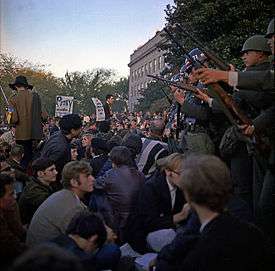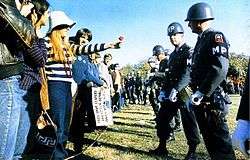Flower Power (photograph)

Flower Power is a historic photograph taken by American photographer Bernie Boston for the now-defunct Washington Star newspaper. It was nominated for the 1967 Pulitzer Prize.[1] Taken on October 21, 1967, during the National Mobilization Committee to End the War in Vietnam's march to the Pentagon, the iconic photo shows a Vietnam War protestor placing a carnation into the barrel of a rifle held by soldier of the 503rd Military Police Battalion.[2]
When the antiwar demonstrators approached the Pentagon, Boston was sitting on top of a wall of the Mall Entrance when he saw a lieutenant march a squad of guardsmen into the crowd of demonstrators. The squad then formed a semicircle around the demonstrators, the young man in the photo emerged from the crowd and started placing carnations in the rifles. Boston took it as an opportunity to capture the moment, seeing that "everything came together" and he had a good angle sitting on top of the wall.[3]
When Boston showed the photograph to his editor at the Washington Star, he "didn't see the importance of the picture" so it was put aside. Instead, Boston started entering it in photography competitions, where it earned its recognition.[4]
Subject

Many debates have been brought up as to the identity of the young demonstrator placing the carnations in the gun barrels on that day. According to a 2007 Washington Post article by David Montgomery, his name is George Edgerly Harris III. Harris was a young actor from New York, about 18 years old, who later made the Summer of Love pilgrimage to San Francisco that for which the hippie movement was famous. There, he came out as gay, changed his name to Hibiscus, and co-founded of The Cockettes, a "flamboyant, psychedelic gay-themed drag troupe."
Harris died in the early 1980s during the beginning of the AIDS epidemic.[5]
The Huffington Post suggested that the protestor was Joel Tornabene, in an article written by Paul Krassner in 2008, after Bernie Boston's death. Tornabene was described by Krassner "as an unheralded Yippie organizer known as Super-Joel," who convinced him that his grandfather was Mafia boss Sam Giancana and who had escaped participating in the family business by making money selling LSD.
However, this rumor of the Giancana relation was debunked when Tornabene's sister wrote to Krassner after the publication of his autobiography Confessions of a Raving, Unconfined Nut: Misadventures in the Counterculture. Krassner only became aware of this information after Tornabene's death in Mexico in 1993.[6]
Photographer
Bernie Boston was born on May 18, 1933, in Washington, D.C., and graduated from the Rochester Institute of Technology with a degree in photography, after which he studied at the School of Aviation Medicine in the U.S. Air Force. He served in the Army for two years while in Germany practicing radiology "in a neurosurgical unit." In 1958, he left the Army and returned to Washington, working in custom photofinishing.[7]
Tired of working as a freelancer in photography, he joined the staff of the Dayton Daily News in Ohio five years later. After three years, he returned to Washington and joined the staff of the Washington Star, within two years becoming the director of photography. He remained in that position until the paper closed in 1981, moving on to work at the Los Angeles Times.
In 1967, the same year he captured Flower Power, Boston was commissioned to shoot a portrait of former Black Panther H. Rap Brown. Noticing the trend of a call for civil rights in the late 1960s, Boston took more images of the Civil Rights Movement, including a portrait of Reverend Martin Luther King, Jr. during his Poor People's Campaign, and other history-making events.
Boston also photographed every American president from Harry Truman to Bill Clinton. He taught photojournalism classes at Northern Virginia Community College and Rochester Institute of Technology.[7]
Boston died on January 22, 2008, of amyloidosis, a rare blood disease with which he had been diagnosed in 2006.
Awards
In 1987, Boston was a Pulitzer Prize finalist for Photography for a photograph of Coretta Scott King unveiling a bust of her late husband, Dr. Martin Luther King, Jr., in the U.S. Capitol Rotunda.
In 1993, The National Press Photographers Association presented Boston with its highest honor, the Joseph A. Sprague Memorial Award—"the The honor recognizes a working photojournalist who advances, elevates, or attains unusual recognition for the profession by their conduct, initiative, leadership, skill, and devotion to duty." [8] Three years later, he was inducted into the Hall of Fame of Sigma Delta Chi, The Society of Professional Journalists. He also served as a chairman of the National Press Photographers Association (NPPA) Freedom of Information Committee.[9]
Publication
Boston's photography has been published in many books, including The Best of Life, Life: The First Fifty Years, 150 Years of Photojournalism, Life's Classic Moments, and numerous textbooks on government and photography.[7]
Symbolic significance

The Flower Power movement was birthed in Berkeley, California as means of symbolic protest against the Vietnam War. Beatnik writer Allen Ginsberg, in his November 1965 essay How to Make a March/Spectacle, promoted the use of "masses of flowers" to hand to policemen, press, politicians and spectators to civilly fight violence with peace.
The use of nonviolent objects such as toys, flags, candy and music were meant to show that the movement was not associated with anger or violence. Members of the movement even went as far as trying to negate the rallies of the Hells Angels motorcycle gang who supported the war.
Critical acclaim
This photo has had an influential effect on both the antiwar movement of the sixties, and as a visual representation of how photojournalism can help with a movement. Specific exhibits and discussions have been curated solely around this photo by Boston to display the political, cultural and social aspects of the Flower Power movement.
The exhibit "From Kennedy to Kent State: Images of a Generation," was featured at Worcester Art Museum in Worcester, Massachusetts, which displayed Boston's image as a large gelatin silver print. The image was included as a representation of the antiwar movement.[10]
Mass reproduction
The photograph continues to be reproduced as an iconic image of the 1960s.[11]
See also
- The Ultimate Confrontation: The Flower and the Bayonet, for a similar photograph taken by Marc Riboud the same day
References
- ↑ Boston, Bernie (October 21, 1967). "Flower Power". The Washington Evening Star.
- ↑ "Flowers, Guns and an Iconic Snapshot".
- ↑ "Bernie Boston; captured iconic 60s' moment".
- ↑ Stewart, Jocelyn Y. (January 25, 2008). "Bernie Boston; captured iconic 60s' moment - The Boston Globe". Boston.com. Retrieved December 6, 2013.
- ↑ "Flowers, Guns and an Iconic Snapshot". Washingtonpost.com. March 18, 2007. Retrieved December 6, 2013.
- ↑ "Paul Krassner: Tom Waits Meets Super-Joel". Huffingtonpost.com. January 30, 2008. Retrieved December 6, 2013.
- 1 2 3 "Bernard "Bernie" Boston, 74, Retired Los Angeles Times Photojournalist, Was An Icon". NPPA. January 22, 2008. Retrieved December 6, 2013.
- ↑ "Joseph A Sprague Memorial Award". NPPA. Retrieved December 6, 2013.
- ↑ "Npaa - Npaa". Npaaonline.org. November 10, 2013. Retrieved December 6, 2013.
- ↑ "Kennedy to Kent State: Images of a Generation". Worcester Art Museum. October 22, 1967. Retrieved December 6, 2013.
- ↑ Mulligan, Therese. "Bernie Boston: American Photojournalist". ISBN 9781933360195. Retrieved December 6, 2013.